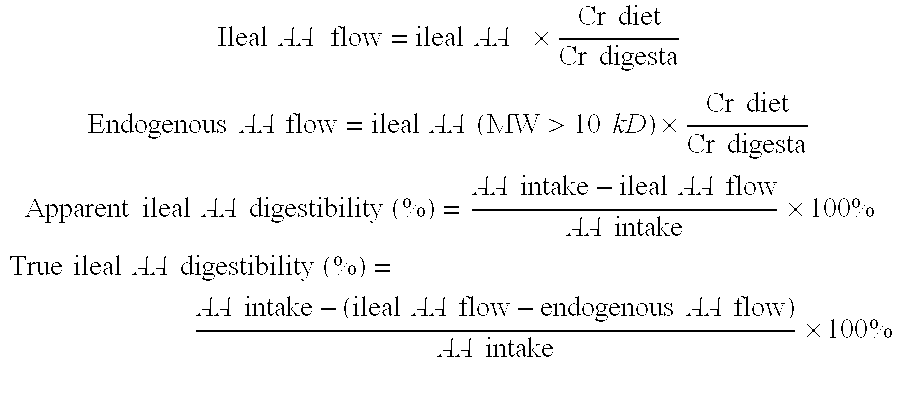Fermented infant formula
a technology for infant formula and infants, which is applied in the field of protein digestion, can solve the problems of imposing a heavier burden on the kidneys of infants and low digestion effort, and achieve the effects of reducing the amount of endogenous proteolytic enzymes detected at the terminal ileum, reducing the amount of digestive effort, and reducing the amount of apparent and true protein digestibility
- Summary
- Abstract
- Description
- Claims
- Application Information
AI Technical Summary
Benefits of technology
Problems solved by technology
Method used
Image
Examples
example 1
[0078]A double-blind, placebo-controlled, randomised, prospective study with parallel group design was conducted in healthy term born infants until the infants' age of one year. The test groups were:
Group 1: Infants on full formula feeding after 2 months at the latest receiving a standard non-hydrolysed cow's milk based formula (N=41). Group 2: Infants on full breastfeeding for at least 4 months (N=43).
Stool samples were collected at week 16 after birth and stored at −20° C. until further analysis. Faecal proteolytic activity was measured with the EnzCheck protease fluorescence based assay kit (E6638, Invitrogen, Carlsbad, Calif., USA) for detecting metallo-, serine and sulfhydryl proteases. Faecal samples were 1000× diluted in 1×PBS, centrifuged at 13.000 rpm for 3 minutes to remove large particles, and 100 μl supernatant was added to 100 μl working BODIPY casein (10 μg BODIPY casein). Increase in fluorescence was measured at 25° C. for a period of 10 minutes. Porcine pancreatin (S...
example 2
Animal Experiments
[0080]To investigate protein digestion in vivo, pigs are first choice since they highly resemble human digestive physiology (Miller et al. 1987, Annu Rev Nutr, 7:361-82) and generate comparable true ileal nitrogen and amino acid (AA) digestibilities (Deglaire et al. 2009, Br J Nutr, 102(12):1752-9, Rowan et al. 1994, Br J Nutr, 71(1):29-42). In addition, a study by Moughan et al. has shown that three-week-old piglets can be used as a model for 6-month-old infants (Moughan et al. 1991, J Nutr, 121(10):1570-4). Therefore, AA digestibility of a fermented and standard infant formula (IF) was tested in a piglet model. A hydrolyzed formula (Nutrilon Pepti) was used to correct for endogenous AA losses according to the peptide alimentation method (Rutherfurd et al. 1998, J Dairy Sci, 81(4):909-17).
[0081]Six age- and weight matched male piglets (average weight 4.9 kg) were housed in groups from 2 weeks of age. At three weeks of age they received a T-cannula at the distal pa...
example 3
[0095]A reconstituted infant formula comprising per 100 ml:
12.3 g dry matter, 66 kcal
1.19 g protein (bovine whey protein / casein in 1 / 1 weight ratio), 7.2% based on total calories
7.76 g carbohydrate (mainly lactose)
3.36 g fat (mainly vegetable fat).
[0096]Of this composition 30% based on dry weight is derived from lactofidus-1 as described in example 2. The composition further comprises, vitamins, minerals, trace elements and other micronutrients according to international directives.
PUM
| Property | Measurement | Unit |
|---|---|---|
| temperature | aaaaa | aaaaa |
| temperature | aaaaa | aaaaa |
| temperature | aaaaa | aaaaa |
Abstract
Description
Claims
Application Information
 Login to View More
Login to View More - R&D
- Intellectual Property
- Life Sciences
- Materials
- Tech Scout
- Unparalleled Data Quality
- Higher Quality Content
- 60% Fewer Hallucinations
Browse by: Latest US Patents, China's latest patents, Technical Efficacy Thesaurus, Application Domain, Technology Topic, Popular Technical Reports.
© 2025 PatSnap. All rights reserved.Legal|Privacy policy|Modern Slavery Act Transparency Statement|Sitemap|About US| Contact US: help@patsnap.com

